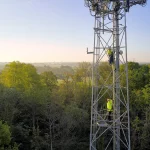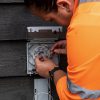Community Fibre CEO on Building FTTP, Obstructive Landlords and Skills

The CEO of London-based broadband ISP CommunityFibre, Graeme Oxby, has told ISPreview.co.uk in a new interview that the “biggest obstruction” they face in quickly and cost-effectively deploying their 10Gbps capable Fibre-to-the-Premises (FTTP) network is a lack of support from UK landlords, among other things.
Until recently CF – supported by an initial investment pot of around £90m from private investors (e.g. Amber Infrastructure and RPMI Railpen) and Government backed schemes – had been working to deploy their “full fibre” network to cover more than 500,000 UK premises by the end of 2022. The vast majority of this has been focused upon the London area and large residential apartment buildings / social housing (MDUs) or office blocks.
However, in July 2020 the aforementioned target was given a significant boost to 1 million homes and businesses by the end of 2023, which occurred after the provider secured a major investment of £400m from global equity firm Warburg Pincus LLC and management group DTCP (here).
Advertisement
The extra funding has turned the provider into a much more significant player and that’s on top of the fact that they also have some of the cheapest “full fibre” packages of any commercial ISP. Residential packages tend to start at just £20 per month for 50Mbps (free installation) and that goes up to £49 for 920Mbps.
Despite this the provider’s CEO notes that they and other providers still have some challenges to face, such as the not insignificant problem of a lack of support from landlords (e.g. building owners). “This lack of enthusiasm is reflected in slow and long-winded processes to issue wayleaves [legal access agreements] and slow internal approval to build processes,” said Graeme.
The issue is sadly nothing new and has been raised by most urban-centric broadband network operators at one time or another. The UK Government are moving to try and tackle this via new access rights (here), but CF wants more: “We would like to see the Government support PM Boris Johnson’s encouragement to scrap local planning consent and ‘Build, Build, Build’ in the housing sector and do that for the fibre industry.”
In our full interview (below) we also cover issues of competition and overbuild between networks, as well as the current problem of engineer shortages and various other topics.
Advertisement
The Community Fibre Interview
Q1. Firstly, congratulations are in order following the new £400m investment deal with global equity firm Warburg Pincus LLC and management group DTCP. Prior to this we recall that Community Fibre originally held an ambition to reach 500,000 premises by the end of 2023, but now you’re aiming for 1 million by the end of 2022. Is this forecast increase in build-rate entirely down to the latest investment or have you found efficiencies elsewhere?
ANSWER:
Thank you, this is an exciting deal for Community Fibre and having Warburg Pincus and DTCP on board is a tremendous endorsement for our business. In a post COVID19 world, digital connectivity will be more crucial than ever, making our plan to get to 1 million homes passed by the end of 2023 vital.
Our acceleration from 500,000 to 1 million is down to both investment and efficiencies. We are growing quickly and we are delivering efficiencies in every area of our business. The extra funding allows us to build to a larger number of homes and businesses but we’ll always have a strong focus on efficient network build.
Q2. Transitioning from a smaller to larger operator can be hard and sometimes providers don’t always get it right (e.g. Gigaclear in 2018/19). What sort of measures are Community Fibre taking in order to ensure that the business scales-up smoothly to cope with a larger and faster build?
ANSWER:
Transitions can definitely be challenging. Our investment comes from the blue chip investment sector which comes with a successful track record of scaling up businesses, and in particular broadband businesses from a global perspective. This will bring huge learnings for our business and best in class insight. Furthermore, our new executive team at Community Fibre have a vast amount of combined experience in running much larger corporations.
However, we are aware of the challenges and are also actively recruiting talent and investing in IT to ensure we can scale up our business and processes. Indeed, the work by OFCOM and Openreach to improve the PIA product has given us the confidence to grow even faster in the future.
Q3. Can you tell us anything about the typical cost per premises passed of your deployment and its penetration after the first 1, 2 or 3 years? For example, Openreach’s current FTTP roll-out is costing around £300 – £400 per premises and Virgin Media’s estimate is around £620 (VM is seeing about 30-35% penetration after 3 years)?
ANSWER:
We currently are not publicly releasing our cost per premise numbers but suffice to say we have a very low cost versus industry benchmarks given our primary focus on going to MDUs combined with our rapid deployment methods. Ultimately this allows us to deliver the best broadband at the best prices which is resulting in accelerating customer growth.
Q4. Community Fibre are perhaps one of the cheapest of the commercial gigabit broadband ISPs in the market right now. How are you able to maintain that level of pricing and what sort of impact does it have on your expectations for build payback on the long-term investment (e.g. operators tend to have payback windows of 10-20 years)?
Advertisement
ANSWER:
Community Fibre is the leader in providing the best speeds at the best prices in London and our low cost to build ensures that we have a sustainable model with good paybacks.
Q5. Last year we reported that CF were conducting a Single Dwelling Unit (SDU) trial with individual houses in London. Can you tell us a little about that and roughly what plans you might have for deployment to SDUs in the future, which are obviously a lot more costly to tackle than MDUs (apartment blocks)?
ANSWER:
Our aim at Community Fibre is to provide the highest quality full fibre and the most affordable prices across London. The trial provided useful information about what it might cost to pass single homes and to better understand how we might pass other building types as we extend the network.
Q6. Ofcom has begun to consult on some of the changes that might be needed in order to help facilitate investment in new full fibre and gigabit capable broadband networks. Many of the proposals relate specifically to Openreach, but some – such as migration processes for full fibre networks (moving away from copper), a new Dark Fibre product and regulation that varies by geographic area – may also affect other providers.
What are your thoughts on Ofcom’s proposals and do you think that they need to make any other changes in order to help the investment case and roll-out of such networks?
ANSWER:
The single biggest obstruction to quickly and cost-effectively enable fibre adoption in the UK is the lack of support from the majority of landlords in quickly enabling their residents to have the best possible broadband. This lack of enthusiasm is reflected in slow and long winded processes to issue wayleaves and slow internal approval to build processes.
Operators like Community Fibre can build at pace and to very high quality and safety standards and clearly have the money available to roll out the networks at no cost to landlords. So, whilst Ofcom’s efforts in some sectors of the market are welcome they won’t make a lot of difference unless landlords are encouraged or persuaded to support fast full fibre network roll-out.
We would like to see the Government support PM Boris Johnson’s encouragement to scrap local planning consent and “Build, Build, Build” in the housing sector and do that for the fibre industry.
Q7. The Government are currently planning to invest £5bn in order to help those in the final 20% of hardest to reach (mostly rural) premises gain access to gigabit-capable broadband (aspiration is to cover every UK home by the end of 2025), which could involve various technologies such as FTTP, 5G, fixed wireless and DOCSIS 3.1 etc.
Obviously this is somewhat outside of CF’s city-centric focus, but do you have any interest in bidding on related contracts at all and what are your thoughts on the viability of that 2025 target in general?
ANSWER:
At Community Fibre we think there is a large majority of London that is poorly served by the current incumbent providers in the market. We would like to see the Government support the 100% full fibre players that are trying to reach the poorly connected population and lessen the digital divide. To ignore the investment that inner London needs is depriving a necessary utility for many, especially in a post-pandemic world.
Q8. Commercial competition between full fibre (FTTP) providers in urban areas has become increasingly aggressive, which is something that CF will be very familiar with. Indeed, over the past few months we’ve started to see more examples where three providers have all built networks in the same area (overbuild).
The Government’s 2018 Future Telecoms Infrastructure Review made clear that “at least a third (with the potential to be substantially higher) of UK premises are likely to be able to support three or more competing gigabit-capable networks.“
On the one hand this gives consumers extra choice and a better chance of getting a good deal. On the other hand, locals suffer more disruption from multiple builds, while overbuild does little to improve overall UK coverage and can also make it harder for providers to attract investment by stretching the payback period or risk. What is your position on all this and how might it be tackled, if at all?
ANSWER:
We strongly believe that customer choice is good thing, after all the lack of choice is why the country is so poorly and expensively served by the incumbent providers. It’s obviously nice to be the only provider in town, but probably not very realistic over the long term. There aren’t many streets which have more than one provider, so the much talked about examples with 3 competitors are still very much a tiny minority of cases.
For the longer term, if you face an overbuild situation you just need to be very disciplined on costs and have a slick sales effort to quickly gain share, all of which is possible and can lead to attractive returns. At Community Fibre we have the best speeds and the best prices and indeed the best overall service according to customers on Trustpilot, where we have consistently been the UK’s number one ISP.
While we believe that we will continue to be successful, we are mindful of the prevalent digital divide that exists in London. Of course fibre-optic cables running to the home are small and so it is possible to have multiple cables running to properties discreetly. Landlords and Government should be discouraging the use of larger and older copper based technologies in city centres.
Q9. Fears have been raised from a number of quarters, including privately by some other ISPs, that the rush by various companies to build full fibre networks may be putting a strain on the supply of skilled engineers (i.e. demand outstripping supply).
Have you experienced this and, if so, what do you think needs to happen in order to resolve it and should the Government be making any changes to facilitate that?
ANSWER:
We believe that there is a need for the Government to support more education and training/re-training to increase the skill base in the long term, but also there is a responsibility on industry players to do their bit. We look at the skills shortage as a luxury problem in a post-COVID world when compared to the challenges of other industries that have been laid bare by the pandemic.
The good news is that with the re-sizing of many industries, we will be able to offer recruitment and training in all areas including technical. Indeed during Lockdown we increased our employee base substantially we will be continuing to grow rapidly in the months to come and if anything see a loosening of supply side constraints as many more people seek employment.
Q10. The UK Government is currently providing a 5 year relief from business rates on new fibre and Scotland has just pushed this to 10 years. Do you think that the UK should be extending their 5 year relief further, such as to 10-15 years, and if so then why?
ANSWER:
Yes we believe Business Rates Relief for new fibre should be extended at least until HM Treasury has completed its review of Business Rates that it is currently consulting on.
Q11. Finally, CF has so far been laser focused on London and that looks set to continue for the foreseeable future. We’ve previously been told by your former CEO that the ISP may look to build outside of London in the future. Are you able to provide any update on your plans for that and where else you might consider targeting?
ANSWER:
Our recent successful investment round very clearly laid out our plans for London and the work that needs to be done, so at the moment we are laser focussed on delivering on those goals. However, we wouldn’t rule anything out in the future.
A big thank you to Graeme for agreeing to take part in this interview and for keeping us up-to-date with the operator’s progress.
Mark is a professional technology writer, IT consultant and computer engineer from Dorset (England), he also founded ISPreview in 1999 and enjoys analysing the latest telecoms and broadband developments. Find me on X (Twitter), Mastodon, Facebook, BlueSky, Threads.net and Linkedin.
« ISP BT Trials New Kit to Make Home Broadband More Reliable






















































I wish they would define “London” as within the M25. As I might have a hope in hell of getting a Fibre service before 2025
Theee guys are reducing the digital divide at little cost, other than previously vouchers, to the tax payer.
CF, HYPER, City etc spurred OR into action and proved that it was all possible.
The eternal puzzle was why OR never piled into the MDU arena? I suspect the answer was more dogma and orthodoxy than anything real.
A Builer probably its complex and hard and pretty bespoke and one of most challenging type type of building to serve
Comment from Community Fibre cEO , whilst Ofcom’s efforts in some sectors of the market are welcome they won’t make a lot of difference unless landlords are encouraged or persuaded to support fast full fibre network roll-out.
So how are Community Fibre and Hyperoptic doing so well with it.
They are nice guys but there is no special sauce there!!
I’d say with a tall MDU with a riser duct it is if anything simpler than just a out anything you can think up.
Long live the Altnets. Well done to them all.
CF playing their cards close to their chest here. They don’t seem to have much of a business plan outside of MDUs in inner London, which are quickly being covered. Looking at ESSIDs on my estate they don’t seem to have attracted many customers yet. I’m expecting price rises soon, nobody else comes close on value.
I’m a happy customer though, don’t get me wrong. They’re pretty hard to fault.
Some greedy landlords only care about getting their rent money and couldn’t care less about leaky pipes, broken washing machines, let alone broadband.
Looks as if Community Fibre are rolling out fibre at Single Dwelling Units near my parents – they are in Victorian terraced housing – in SW London
Sadly, it didn’t seem they are doing my parents street – which is very unfortunate as Virgin Media (Videotron) also missed this when they rolled out cable here as well.
Recently had a letter through the door from Community Fibre. They’re going to be digging my road and laying fibre 😉 So glad that they’re rolling out to house’s and not just flats. Now i have an alternative to Virgin Media. Happy Days!!!!
Oh I’m in NW London
I hope that their customer experience levels improve.They have been advising connection to E6 since January 2021, but repeatedly miss their one start dates. NOT IMPRESSED